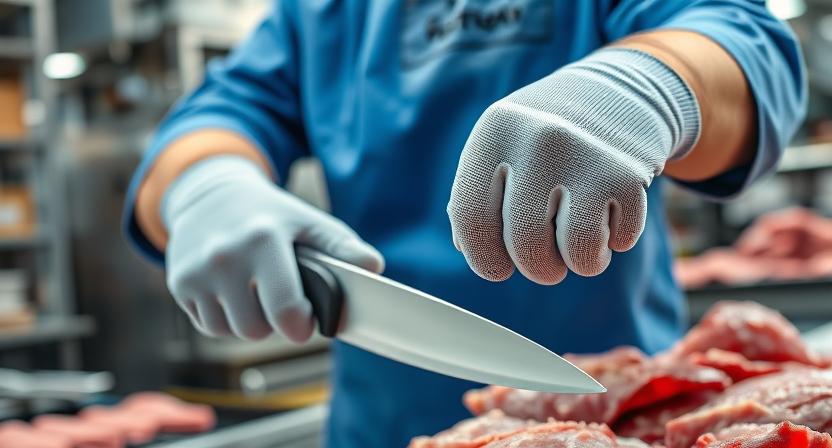Cut Resistant Gloves for Food Processing: What to Look For

Introduction
In the fast-paced world of food processing, worker safety is non-negotiable. Cut-resistant gloves are essential for protecting employees from sharp knives, slicers, and machinery while maintaining hygiene and dexterity. But with so many options available, how do you choose the right pair? This guide breaks down the critical factors business owners, purchase managers, and safety product suppliers should consider when selecting cut-resistant gloves for food processing.
Why Cut-Resistant Gloves Are Essential in Food Processing
Food processing involves handling sharp tools, deboning meat, slicing vegetables, and working with automated machinery—all of which pose cut hazards. According to the U.S. Bureau of Labor Statistics, hand injuries account for a significant percentage of workplace accidents in manufacturing.
Cut-resistant gloves help:
✔ Prevent lacerations from blades and equipment
✔ Improve grip in wet or oily conditions
✔ Maintain hygiene with food-safe materials
✔ Boost productivity by reducing injury-related downtime
Key Features to Look for in Cut-Resistant Gloves
1. Cut Resistance Level (ANSI/ISEA Ratings)
Cut resistance is measured using the ANSI/ISEA 105 standard, which ranks gloves from A1 (lowest) to A9 (highest) protection.
A1-A2: Light-duty tasks (handling small knives)
A3-A5: Medium-duty (meat deboning, vegetable slicing)
A6-A9: Heavy-duty (industrial meat processing, bone handling)
For most food processing tasks, A3-A5 offers the best balance of protection and flexibility.
2. Material and Durability
The best cut-resistant gloves for food processing are made from:
High-Performance Polyethylene (HPPE): Lightweight, flexible, and highly cut-resistant
Stainless Steel Mesh: Maximum protection but less flexible
Nitrile Coating: Improves grip and resists oils/liquids
Avoid latex if workers have allergies—opt for nitrile or polyurethane coatings instead.
3. Comfort and Dexterity
Workers need gloves that allow precise movements. Look for:
Ergonomic design (pre-curved fingers)
Breathable fabric to reduce sweating
Adjustable cuffs for a secure fit
4. Hygiene and Cleanability
Since food safety is critical, gloves should be:
✔ Machine-washable (for reusable gloves)
✔ Powder-free to avoid contamination
✔ FDA-compliant for direct food contact
5. Grip Enhancement
Slippery surfaces increase injury risks. Gloves with:
Nitrile dots or textured palms improve grip
Oil-resistant coatings prevent accidents in greasy environments
Common Mistakes When Choosing Cut-Resistant Gloves
❌ Prioritizing price over protection – Cheap gloves may lack durability.
❌ Ignoring sizing – Poor fit reduces effectiveness.
❌ Overlooking compliance – Ensure gloves meet ANSI, FDA, and OSHA standards.
Final Thoughts: Invest in the Right Protection
Choosing the right cut-resistant gloves for food processing ensures worker safety, compliance, and operational efficiency. Whether you’re a safety product supplier, purchase manager, or business owner, prioritize ANSI-rated, durable, and ergonomic gloves that meet industry standards.
Need high-quality cut-resistant gloves? Explore our range of OSHA-compliant gloves or contact our safety experts today for personalized recommendations!
FAQs: People Also Ask
What is the best cut-resistant glove rating for meat processing?
For meat processing, A4-A6 provides optimal protection against deep cuts while maintaining flexibility.
Can cut-resistant gloves be used with wet food?
Yes, but ensure they have water-resistant coatings (like nitrile) to maintain grip.
How often should cut-resistant gloves be replaced?
Inspect gloves daily—replace if torn, frayed, or losing cut resistance. Reusable gloves last 3-6 months with proper care.
